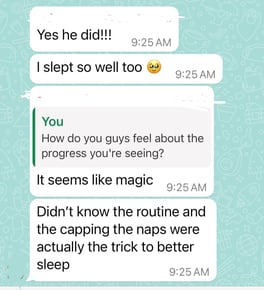Can You Co-sleep And Sleep Train?
Bed sharing or co-sleeping and sleep training can happen. But not in the way traditional sleep training methods are usually designed for independent sleep. I've helped many bed sharing families get back their sleep!
Sarah Ong
5/22/20255 min read


My short answer is, yes!
It's possible to sleep train while bed sharing, but it requires a more flexible approach.
Traditional sleep training methods are usually designed for independent sleep. Still, if a family prefers co-sleeping, it’s about finding a balance that respects both the child's need for closeness and the parents' desire for better sleep.
While most parents come to me for help to move away from accidental or intentional bed sharing, there have also been parents who want to continue bed sharing but want their baby or toddler to sleep longer without having to nurse or rock them back to sleep.
For this group of parents, I first get super clear about their end goal.
Most of them don't care much about independent sleep for their child. They want to maintain those lovely cuddles in their bed. But they do want less disruptive sleep, and for their baby to just go back to sleep with some shhh and maybe a hand on them.
These parents need support in reducing those sleep cries, sitting up crying, boob demands, or the need to be rocked/held to sleep.
Enter sleep optimisation and responsive settling.
Sleep Optimisation
Let's do a little refresher on how sleep actually works.
Sleep is controlled by two main factors: the circadian rhythm (body clock) and sleep homeostasis, a.k.a. sleep drive or sleep pressure.
The circadian rhythm is the body's internal clock that regulates sleep-wake cycles based on light and darkness cues over a 24-hour period. It affects hormones, digestion, body temperature, and other bodily functions. External cues can help maintain a precise 24-hour rhythm.
Sleep homeostasis regulates the need to sleep when the "pressure" is high and the need to be awake when the "pressure" is low. The amount of time you stay awake creates this sleep pressure. The more you stay awake, the stronger the "sleep drive" becomes, making you feel sleepier.
In child sleep, the amount of time a child spends awake varies with age and unique sleep needs. This is also widely known as wake windows.
Knowing this element of sleep science is fundamental to forming healthy sleep habits for your child.
But how do you determine your child's ideal sleep and nap timings, since all children have different needs?
A sleep log or diary will be the most helpful place to start. If you don't already keep track of your little one's sleep and feeding times, start by jotting down important information such as morning wake-up time, nap times, bedtime, night wakings, feeding times and also the amount that your baby drinks each time.
You can do this through an app, or use a pen and paper. After 7 days, you will see a pattern, and how much sleep they need in total 24 hours.
If you're a client, I will use this information to propose a recommended sleep schedule and bedtime routine that fits your family's lifestyle.
So when there is a rhythm, there's nothing much parents need to do. Their child will simply fall asleep when they're ready and tired enough.
Responsive Settling
Now if your baby or toddler has been going to sleep with lots of external help from you, such as nursing or rocking, then when they wake up at night, after completing a sleep cycle, they will naturally look for the same way to go back to sleep again. This will repeat several times during the night.
The way to get your baby to sleep longer without these repeated behaviours is to break the association and teach them new ways to settle without it.
If you have read that there's simply no way to teach a baby not to nurse themselves to sleep if they’re sleeping right next to you, that's just BS and completely untrue.
Is this going to be easy? Absolutely not. Your baby will have big feelings about you limiting access to nursing or rocking. And that's completely okay.
When Angie* and Sean* came to me for help, their 10-month-old baby Jack* was waking up every 1.5-2 hours at night and would require nursing to go back to sleep. There was also a strong bottle to sleep association at the beginning of naps and bedtime. Baby also slept in their bed.
They weren't sure which way to go at first. Either cot sleep next to parents' bed or continue bed sharing. They tried with cot sleeping but it didn't go well for Jack. So we went with the bed sharing option.
Here were some highlights from the comprehensive sleep plan I tailored to their unique sleeping arrangement:
There were clear boundaries set from the beginning. They established a consistent bedtime routine and clear signals that it’s time for sleep. We made sure that the milk bottle was being offered first with the lights on, followed by silly time, story time and then lights out. This was intentional to break that milk-sleep association.
Then they worked on responsive settling. This is done by meeting Jack's emotional needs while gradually encouraging him to settle into sleep. This involved offering comfort with closeness, hugs and a soothing voice instead of picking him up or nursing him every time he woke.
They limited night feed with a bottle each night at 5am.
There were lots of tears at first, but after one week, there was a huge improvement in the fussing and crying. Jack started sleeping at a much longer stretch and around day 12, he began to sleep through without the 5am milk feed, clocking in 11 hours of night sleep.
The parents need not intervene with the small sleep cries because Jack got better at putting himself back to sleep.
When asked how they felt about the progress, this was what they shared:


Capping the naps was also part of the sleep optimisation strategy to create enough sleep pressure to support Jack's night sleep.
The bedtime routine, which includes present time and connection, has also reduced the protests and crying when the lights go out.
*Names have been changed to protect their privacy.
Do you resonate with this family's situation? Can you envision doing the same thing with your child?
It's never too late, even if your 2-year-old is nursing to sleep. You will learn and walk away with powerful tools to overcome toddler sleep problems with confidence.
Get in touch and let's chat on Instagram DM.
Disclaimer: While sleep optimisation and responsive settling can be successful for some babies and families, it is important to acknowledge that outcomes can vary, and this approach may not be suitable for all individuals. It is crucial to understand that some babies and toddlers may not respond to the same approaches as others. Parental consistency, patience, and responsiveness are key elements in the process, and it is possible that adjustments or modifications to the approach may be needed to fit the temperament of the child.
I've got more than a decade of experience and the skills to work with the toughest sleep cases, especially with toddlers.
All my strategies for clients are carefully curated and personalized to suit the child's temperament and family's lifestyle.
Holistic Sleep Coach
© 2024. Sarah Ong. All rights reserved.







